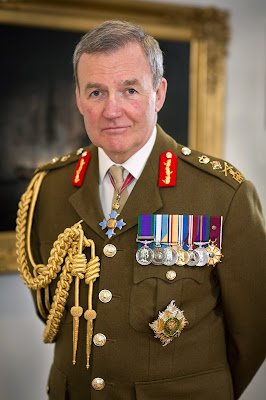 |
| Gen. Sir Nicholas Houghton, Chief of the Defence Staff of the British Armed Forces gives MILITARY TECHNOLOGY an exclusive statement on the state of UK defence, to be read in #9/2015. |
The last 18 months have seen significant challenges to the international rules based system with NATO at the forefront of the response. The renewed focus on NATO as the guarantor of security in Europe is clear for all to see. The Wales Summit last September came at a pivotal time for the Alliance and the UK is playing a leading role in delivering the commitments made by Allies.
The enhancements to the NRF being implemented as part of the RAP heralded at Wales will see a more capable force at higher readiness, better able to tackle the full spectrum of challenges the Alliance might face. The creation of the VJTF and the Immediate Follow-on Forces Group ensure that NATO has the ability to respond quickly and decisively. These elements will see NATO better able to respond to threats and challenges and there is clear resolve from Allies to ensure NATO can deliver highly capable and sustainable forces at speed and at scale. The ability of NATO to call upon truly multinational forces held at high readiness ensures that it can play a central part in managing crises across Alliance territory and beyond. This is an ambitious but appropriate response by NATO to the evolving security environment and demonstrates the collective resolve of all 28 Allies.
Whilst adaption of the NRF is important, more important is its resourcing by Allies. Events of 2014 and the decisions reached at the last Summit have demonstrated that Allies are more committed than ever to putting NATO at the heart of European defence.
The UK has been a leading contributor to NATO’s assurance and adaption efforts. Across 2014 and 2015 the UK has undertaken two rotations of the Baltic Air Policing mission and will have deployed in excess of 7,000 personnel on exercises with Eastern Allies. The UK is also central to the successful implementation of the VJTF, contributing a Battle Group to the Spanish framework in 2016 and committing to lead the VJTF during 2017.
The changing security environment means the Alliance must ensure it adapts to the challenges and threats that present themselves now and in the future. The NATO Forces 2020 goals agreed at the Chicago Summit committed NATO to deliver a coherent set of deployable, interoperable and sustainable forces able to meet NATO’s level of ambition. Modern, effectively connected forces that can operate together and with partners in any environment are essential to NATO and its ability to respond to emerging threats. The Connected Forces Initiative (CFI) is a robust and multifaceted project providing the structure for Allies to train and exercise, reinforcing full-spectrum joint and combined training and promoting interoperability (including with partners). The CFI will be a means to deliver the training and exercise element of the RAP and will complement and reinforce NATO Forces 2020 by improving NATO’s readiness and responsiveness.
Whilst a great deal of adaptation has already been completed, with other key work strands underway, there is still more that NATO could do. Adaptation of the military aspects of the Alliance is important but so is the adaptation of the wider institution, including the speed of decision making.
As the threat changes, so must our Armed Forces. In the last 18 months we have been exposed to a more integrated use of hybrid warfare to the East of NATO and a challenging and complex security environment on the Southern flank. A key element for NATO is shared situational understanding, enabling the Alliance’s decision making; therefore, Intelligence Surveillance and Reconnaissance assets with the ability to disseminate information will be vital in providing that understanding. At NATO’s heart is the principle of collective defence and with it, deterrence. Therefore, the ability to understand should be coupled with the coordination, synchronisation and application of military effects across all environments to reassure Allies and deter aggressors. This includes cyber, which is increasingly being used against us. Maintenance of information superiority in modern conflict needs to be as much a priority as air superiority and therefore, nations need to ensure that their cyber defence capabilities are as strong as possible. There is, however, still a place for “traditional” forces, providing visible deterrence and reassurance through the deployment of technologically advanced military strength, such as 5th generation fighter aircraft, precision guided munitions and advanced maritime platforms.
NATO's greatest strength is its unity. Through 2020 and beyond, stimulated by the requirement to use defence resources in the most efficient way, we will further strengthen that unity to maintain and upgrade NATO's military strength. NATO is the most successful military alliance in history, we and our Allies are clear that we will ensure it retains that status.
Gen. Sir Nicholas Houghton, Chief of the Defence Staff of the British Armed Forces
Full statement along with other Chiefs of Defence in MILITARY TECHNOLOGY #09/2015, available at DSEI on booth #S2 165. Please frequently check back for more NEWS FROM THE FLOOR.

No comments:
Post a Comment